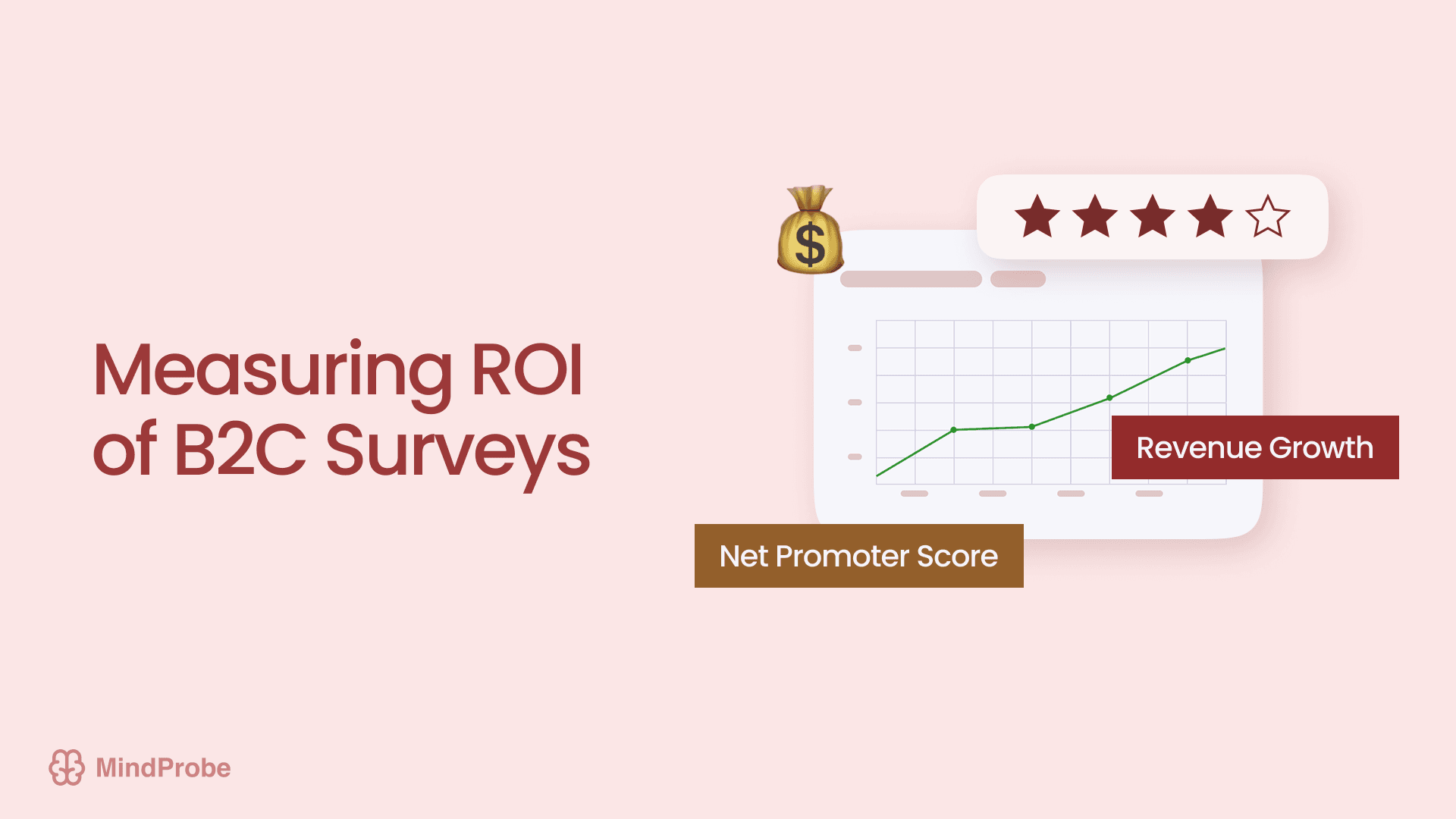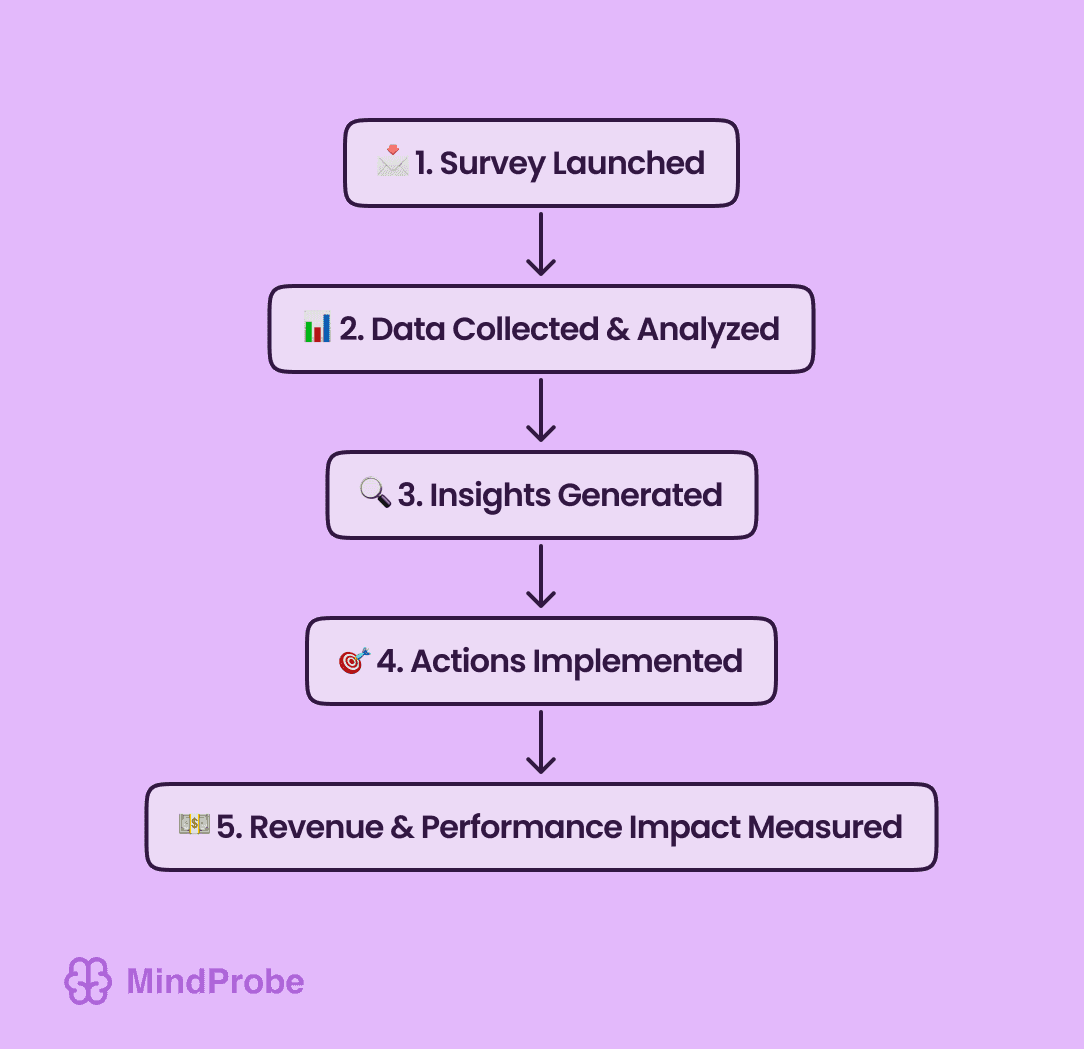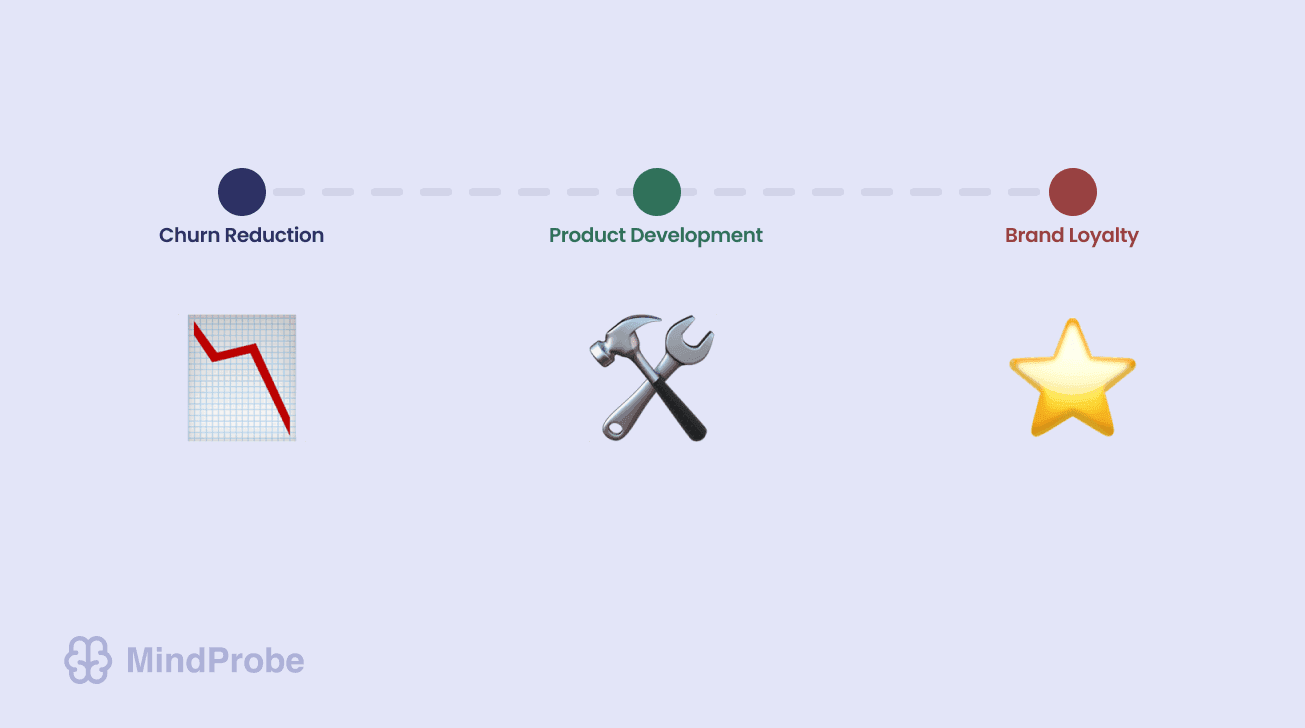Calculating ROI: How to Measure the Impact of Your B2C Surveys
Samee

Learn how to calculate and maximize the ROI of B2C surveys. Discover proven methods, key metrics, and how MindProbe’s AI-driven platform helps you link customer feedback to tangible financial results.
1. Introduction
B2C companies whether e-commerce retailers, subscription services, or traditional brick-and-mortar brands often rely on surveys to gather critical insights. From feedback forms to customer satisfaction questionnaires, surveys play a vital role in understanding buyer preferences, pinpointing pain points, and guiding product roadmaps. But how do you prove that these surveys contribute to the bottom line? This is where Return on Investment (ROI) measurement comes into play.
Calculating the ROI of your B2C surveys isn’t just about justifying time and budget it’s about demonstrating how data-driven decisions lead to improved customer satisfaction, product innovation, and revenue growth. In this comprehensive guide, we’ll walk through the key components of measuring survey ROI, from setting clear objectives to leveraging advanced analytics tools like MindProbe. Whether you’re a marketing manager, product lead, or business owner, understanding and communicating the value of survey research can help secure buy-in, expand budgets, and strategically shape your B2C efforts.
2. Why Measuring ROI on B2C Surveys Matters
In a climate where marketing budgets and product development resources are highly scrutinized, every initiative must show value. Surveys can sometimes be viewed as ‘nice-to-have’ rather than a mission-critical activity unless you can point to concrete outcomes.
1. Resource Allocation
- By quantifying financial returns, you can justify the expense of survey software, data analysis teams, or incentives for participants.
2. Actionable Insights
- Connecting insights to tangible results like increased sales, reduced churn, or improved brand sentiment underscores the strategic importance of well-designed surveys.
3. Stakeholder Alignment
- Demonstrable ROI fosters support from executives, investors, and cross-functional departments, ensuring they see the value in continuing or scaling survey initiatives.
4. Continuous Improvement
- Ongoing ROI measurement helps you refine survey methods, identify underperforming segments, and capture new opportunities for growth.
3. Defining Clear Goals and Objectives
Before you can measure ROI, you need a direction. Surveys that lack a specific purpose will produce data that’s hard to interpret, let alone monetize. Key questions to ask:
- What are we trying to achieve? (e.g., reduce subscription churn, enhance customer loyalty, refine product features)
- Which metrics matter most? (e.g., Net Promoter Score, conversion rates, average order value)
- Who is our target audience? (e.g., high-value subscribers, first-time buyers, brand advocates)
- What’s the timeline for expected outcomes? (e.g., a quarter, six months, a year)
This initial clarity ensures your survey design, distribution strategy, and data analysis all align toward actionable goals.
4. Establishing Key Performance Indicators (KPIs)
Once you have a clear objective, identify KPIs that reflect success. These KPIs will help you quantify both the short-term and long-term impact of your B2C surveys.
1. Customer Satisfaction (CSAT)
- A measure of how customers feel about a particular product, feature, or service. Often reported as a percentage or an average score.
- Gauges loyalty by asking how likely a respondent is to recommend your brand. It’s a quick litmus test of overall sentiment.
3. Churn Rate
- Especially relevant for subscription-based models. If surveys highlight specific friction points that, once addressed, lead to a drop in cancellations, that’s a clear ROI indicator.
4. Conversion Rates
- If you run surveys at various touchpoints (e.g., during checkout or after a lead magnet), an increase in completion or purchase rate can be directly tied to survey-led improvements.
5. Revenue per User
- Whether average order value (AOV) or average revenue per user (ARPU), these figures can show how changes informed by survey data influence purchasing behavior.
5. Calculating Direct vs. Indirect Survey ROI
5.1 Direct ROI Metrics
Direct ROI often emerges when survey feedback leads to a specific, trackable change like revising a product feature that results in higher sales or trimming an underused feature that reduces costs.
Formula:
- ROI (%) = Survey Costs(Monetary Gains from Survey-Informed Changes) - (Survey Costs)×100
- Example: If your e-commerce platform invests £10,000 in surveys (including software, analysis, and incentives) and sees a resulting £25,000 increase in net sales due to checkout improvements revealed by the survey, your ROI is 10000(25000−10000)×100=150%.
5.2 Indirect ROI Metrics
Not all benefits are immediately monetizable. Sometimes, surveys inform brand perception, customer advocacy, or product roadmaps in ways that manifest gradually.
- Brand Equity: An uptick in social media positive sentiment may not translate to immediate sales, but it has long-term value.
- Customer Lifetime Value (CLV): If survey-driven improvements increase retention by 5%, the total value of each retained customer multiplies over time.
- Innovation & Product Differentiation: Gaining insights into future trends or consumer pain points can influence new product lines that create competitive advantages.
6. Data Collection and Analysis Methods
6.1 Structuring Your B2C Surveys
To maximize ROI, your surveys must elicit actionable, relevant information:
- Keep It Focused: Each survey should address a specific objective be it feature validation, post-purchase satisfaction, or brand perception.
- Use Branching Logic: Show questions only relevant to certain respondents (e.g., loyal repeat buyers vs. one-time purchasers).
- Mix Quantitative and Qualitative: Combine rating scales for quick metrics with open-ended questions for deeper insights.
6.2 Leveraging Tools Like MindProbe
A robust platform can streamline survey creation, distribution, and analysis:
- Templates: MindProbe offers ready-made survey templates for measuring satisfaction, brand loyalty, and more.
- Automated Distribution: Scheduling surveys post-purchase or post-subscription can ensure feedback is timely.
- Data Organization: Real-time dashboards collate results, highlighting emerging trends or anomalies.
6.3 Using AI for Deeper Insights
AI-powered features such as sentiment analysis and auto-tagging (both available in MindProbe) can quickly categorize open-ended responses into themes e.g., “shipping delays,” “website usability,” “pricing confusion.” This saves countless hours and surfaces recurring issues that might be hurting your ROI.
7. Real-World Scenarios and Examples
7.1 Reducing Churn in Subscription Models
Scenario: A meal-kit subscription service faces a 20% churn rate, losing a chunk of its customer base each month. Through post-cancellation surveys, they learn that delivery timing and customer support frustrations are primary triggers.
- Action: They adjust logistics to offer more flexible delivery windows and enhance support availability during peak hours.
- ROI Impact: Churn dips to 15%, equating to hundreds of retained customers. Calculating the lifetime value of these customers reveals a significant ROI on the survey initiative.
7.2 Improving Product Development Cycles
Scenario: A consumer electronics brand uses surveys to validate features for an upcoming smartwatch. Rather than investing heavily in a misaligned feature, they discover that longer battery life is a higher priority for target buyers.
- Action: The R&D team reallocates resources from niche features to optimizing battery technology.
- ROI Impact: The smartwatch’s positive reception and higher sales volumes underscore how surveys prevented wasted development costs on underutilized features.
7.3 Tracking Customer Satisfaction for Brand Loyalty
Scenario: An online fashion retailer utilizes net promoter score (NPS) surveys. They identify that loyal promoters are 3x more likely to try new collections first.
- Action: The retailer launches an exclusive “early access” program for high-NPS customers, driving incremental revenue from a smaller, dedicated base.
- ROI Impact: The program’s additional income can be directly attributed to insights from the NPS survey.
8. Overcoming Common Challenges in Survey ROI Calculation
8.1 Low Response Rates
- Problem: If only a small subset of your customer base responds, your data may be skewed or insufficient to draw robust conclusions.
- Solutions: Offer incentives (discounts, freebies), keep surveys concise, and distribute them at optimal times (e.g., right after a purchase or product interaction).
8.2 Biased or Inconsistent Data
- Problem: Leading questions or poorly structured surveys can create confirmation bias, skewing results.
- Solutions: Craft neutral, clear questions and consider pilot testing your survey on a small group. AI tools can help identify anomalies or suspicious patterns in responses.
8.3 Difficulty in Linking Actions to Results
- Problem: Implementing changes informed by survey data, but failing to measure the before-and-after difference clearly.
- Solutions: Establish baseline metrics, track changes post-implementation, and compare them over time. Tag each improvement with a unique identifier in your analytics system.
9. Steps to Implementing an Effective Survey ROI Framework
9.1 Plan & Align with Stakeholders
Gather input from marketing, product, finance, and exec teams to ensure everyone agrees on objectives, key metrics, and the desired outcomes. Clear communication up front avoids fragmented efforts down the line.
9.2 Automate Survey Distribution & Data Gathering
By integrating your survey platform such as MindProbe with your CRM or e-commerce system, you can automate triggers (e.g., sending a satisfaction survey 7 days after a purchase). This consistency improves response rates and reliability.
9.3 Analyze and Prioritize Findings
Once data is in, use AI to swiftly categorize qualitative insights. Then, cross-reference these findings with quantitative metrics. For example, if 25% of respondents mention “shipping times,” link that to your shipping cost or fulfillment process to see how it affects conversions.
9.4 Take Action and Reassess
Implement the changes with the highest potential impact first. Monitor your chosen KPIs like churn or NPS to verify improvements. If the metrics move in a favorable direction, you’ve proven an ROI. If not, refine your approach and repeat the cycle.

10. How MindProbe Streamlines ROI Measurement
10.1 AI-Powered Sentiment Analysis & Auto-Tagging
MindProbe’s machine learning algorithms categorize open-ended feedback, highlighting positive, negative, or neutral sentiment, as well as recurring themes like “website usability” or “product packaging.” This accelerates your analysis, so you can see which issues correlate with changes in customer behavior.
10.2 Real-Time Dashboards for Quick Decision-Making
Rather than waiting on monthly or quarterly reports, MindProbe updates results in real time. If you notice a sudden shift in sentiment or a recurring complaint, you can act immediately preventing a minor issue from evolving into a full-blown crisis.
10.3 Advanced Analytics Suite to Power No-code Data Science
Don't know how to code? No problem. MindProbe offers state of the art analytics suite to enable you to become a data scientist with a click of a few buttons. From regressional analysis to TURF, our platform lets you go from correlation to causation.
10.4 Free Subscription Tier
MindProbe offers the most feature-rich free tiers, letting you have a taste of branching logic to AI-driven insights before committing to a subscription. This ensures you experience the platform’s premium capabilities from day one.
11. Future Trends in Survey ROI and B2C Market Research
The market research landscape is constantly evolving, bringing new ways to quantify survey ROI:
1. Predictive Analytics
- Tools will increasingly use historical data to forecast how certain improvements will impact future revenue or churn.
2. Voice of the Customer (VoC) Integration
- Beyond surveys, brands will integrate feedback from social media, online reviews, and call transcripts to form a holistic view. This unified data set can further refine ROI calculations.
3. Automated A/B Testing
- As AI becomes more sophisticated, it will automatically test changes indicated by survey feedback in controlled experiments, measuring direct impact on revenue or conversions.
4. Personalized Survey Experiences
- Hyper-targeted surveys could deliver contextualized questions, improving response quality and forging clearer cause-and-effect relationships between feedback and subsequent results.

12. Conclusion
Measuring the ROI of B2C surveys isn’t just about justifying a line item in your budget it’s about validating the strategic role that customer insights play in driving revenue, retention, and brand loyalty. From establishing precise objectives to picking the right KPIs, each step of the ROI measurement process helps translate raw data into concrete, financially relevant outcomes.
But effective ROI tracking doesn’t happen by accident. It requires a thoughtful framework one that combines sound survey design, powerful analytics tools (like MindProbe), and a willingness to act on the insights you uncover. When done correctly, the result is a virtuous cycle: you ask the right questions, glean actionable intelligence, make impactful changes, and see the bottom-line benefits that prove your surveys’ worth.
Ready to take your survey-driven insights to new heights? Consider integrating a robust, AI-powered solution that offers real-time dashboards, sentiment analysis, and auto-tagging making it easier than ever to track and enhance the impact of every feedback loop.